A strategy for shoveling snow with measurable improvement.
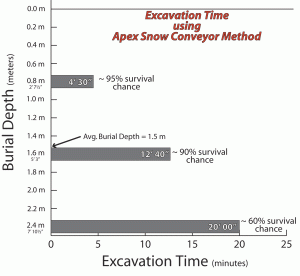 Practicing how to locate a buried victim with an avalanche beacon has become common protocol in avalanche courses, and to a lesser extent, by private parties. However, in the case of a real rescue, locating victims can be accomplished relatively quickly (assuming everyone in the group is using an avalanche beacon). The crux remains the time it takes to extricate a fully buried victim. Dale Atkins and Bruce Edgerly were the first to raise this point, and to be effective, you need a strategy.
Practicing how to locate a buried victim with an avalanche beacon has become common protocol in avalanche courses, and to a lesser extent, by private parties. However, in the case of a real rescue, locating victims can be accomplished relatively quickly (assuming everyone in the group is using an avalanche beacon). The crux remains the time it takes to extricate a fully buried victim. Dale Atkins and Bruce Edgerly were the first to raise this point, and to be effective, you need a strategy.
Unfortunately there is a rather large disparity between the time it takes to dig a victim out and the time a victim can survive being buried. Brugger and Falk report that average extrication times in Europe have dropped from 2 hours to 35 minutes. Dale Atkins and Edgerly say that North American data indicate a time closer to 18 minutes is now the average. While much of the reduction in rescue time is due to improvements in locating victims, thanks to increased use of avalanche beacons, and improvement in beacon technology, the time is still dangerously long.
Atkins and Edgerly’s paper, Strategic Shoveling Techniques was published in 2006 to address this issue. They found the natural tendency for rescuers, after locating the victim, was to dig straight down. This method is fraught with many problems. The key to a speedy excavation is having a strategy to account for moving large amounts of snow quickly and efficiently.
On the European side of the Atlantic, Swiss avalanche consultant Manuel Genswein agreed that a strategy was important, but that more detail was needed to establish a reliable method with measureable results. Using volunteers from Volda University College in Norway, he was able to test several methods and zero in an optimal shoveling strategy which he calls the Apex Snow Conveyor (aka V-shaped conveyor method). It has been adopted by both the Swiss Alpine Club in their Winter Mountaineering Techniques Instruction book and the Canadian Avalanche Center’s online avalanche course.
In a nutshell, Genswein says that the optimum way to move snow is to set up a human conveyor belt, which he dubs the Apex Snow Conveyor. Mining operations use conveyor belts to move lots of ore quickly and efficiently.
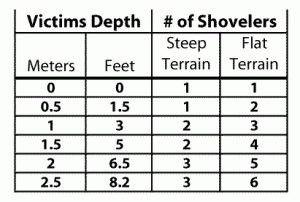 In comparing his findings with Edgerly and Atkins proposal, he says that their study illuminated the qualitative, dimensional aspects of a shoveling strategy. The Apex Snow Conveyor Method was developed by focusing on quantitative data. In other words, optimizing the mechanics of moving as much snow as fast as possible. Through his experiments, Genswein determined that the key to moving lots of snow quickly is to use your shovel in a paddling motion. This minimizes the lifting of snow, which he points out, is inefficient, will lead to exhaustion quicker, slows the excavation, and might ultimately jeopardize the rescue.
In comparing his findings with Edgerly and Atkins proposal, he says that their study illuminated the qualitative, dimensional aspects of a shoveling strategy. The Apex Snow Conveyor Method was developed by focusing on quantitative data. In other words, optimizing the mechanics of moving as much snow as fast as possible. Through his experiments, Genswein determined that the key to moving lots of snow quickly is to use your shovel in a paddling motion. This minimizes the lifting of snow, which he points out, is inefficient, will lead to exhaustion quicker, slows the excavation, and might ultimately jeopardize the rescue.
1. Set up
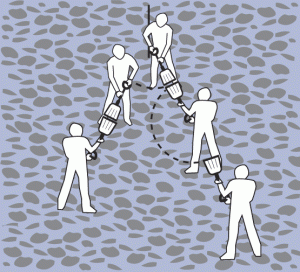 After determining the location of the victim, shovelers arrange themselves in a V-formation. They should be far enough apart that they do not get in each others way while shoveling snow, nor so far apart that they need to continually adjust their position to move snow. As shown in Fig. 3, the downhill reach of the first person’s shovel meets the uphill reach of the next in line. Genswein has determined that this distance is typically 0.8 meters (31 in, approx 1 yard). The length of the V should be twice the burial depth in flat terrain, and equal to the burial depth for steep terrain. This also determines the number of shovelers (see table above).
After determining the location of the victim, shovelers arrange themselves in a V-formation. They should be far enough apart that they do not get in each others way while shoveling snow, nor so far apart that they need to continually adjust their position to move snow. As shown in Fig. 3, the downhill reach of the first person’s shovel meets the uphill reach of the next in line. Genswein has determined that this distance is typically 0.8 meters (31 in, approx 1 yard). The length of the V should be twice the burial depth in flat terrain, and equal to the burial depth for steep terrain. This also determines the number of shovelers (see table above).
2. The Conveyor System
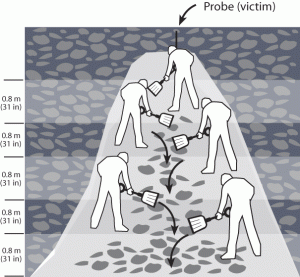 All snow movement, especially for those behind the point position, needs to utilize a paddling motion, so that no energy is wasted lifting snow vertically. In general, each rescuer needs to transport the snow towards the lower end of the V. If there is currently no snow the be transported, the rescuers dig further down. Thus the snow conveyor lowers itself constantly downward with its tip digging at the fastest rate towards the buried subject. The point man begins at the probe. As the hole deepens, the ramp angle that is created by the group shoveling should be gradual, between 20°-25° from the back of the V toward its apex (the tip of the probe/location of the victim).
All snow movement, especially for those behind the point position, needs to utilize a paddling motion, so that no energy is wasted lifting snow vertically. In general, each rescuer needs to transport the snow towards the lower end of the V. If there is currently no snow the be transported, the rescuers dig further down. Thus the snow conveyor lowers itself constantly downward with its tip digging at the fastest rate towards the buried subject. The point man begins at the probe. As the hole deepens, the ramp angle that is created by the group shoveling should be gradual, between 20°-25° from the back of the V toward its apex (the tip of the probe/location of the victim).
3. Maintaining Momentum
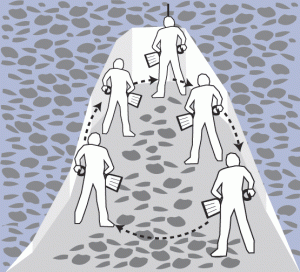 Shoveling is hard work and often done with an unbalanced and compromised posture, so it is important to rotate positions. Genswein suggests a clockwise rotation every four minutes (at most) on command of the person at the tip of the V. In his field studies he found that the first two minutes of shoveling in a new position are the most efficient. Furthermore, rotating positions gives everyone a psychological boost in having something to look forward to, while being long enough for everyone to get in a groove.
Shoveling is hard work and often done with an unbalanced and compromised posture, so it is important to rotate positions. Genswein suggests a clockwise rotation every four minutes (at most) on command of the person at the tip of the V. In his field studies he found that the first two minutes of shoveling in a new position are the most efficient. Furthermore, rotating positions gives everyone a psychological boost in having something to look forward to, while being long enough for everyone to get in a groove.
4. Uncovering the Victim
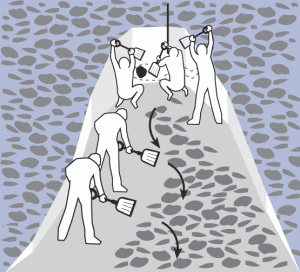 When the victim is reached, the point man changes shoveling tactics so that 1) he doesn’t injure the victim, and 2) to reach the airway as quickly as possible. This will likely involve a shift in digging direction since the probe is probably not at the victims head. The shovelers closest to the point man move to either side to help remove snow immediately around the victims’ body, rather than merely transporting it away. Unless there is a compelling reason, rotation of positions ceases at this phase of excavation.
When the victim is reached, the point man changes shoveling tactics so that 1) he doesn’t injure the victim, and 2) to reach the airway as quickly as possible. This will likely involve a shift in digging direction since the probe is probably not at the victims head. The shovelers closest to the point man move to either side to help remove snow immediately around the victims’ body, rather than merely transporting it away. Unless there is a compelling reason, rotation of positions ceases at this phase of excavation.
5. Immediate Basic Life Support
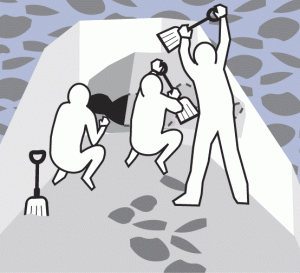 As soon as the victim’s head is accessible, Basic Life Support and /or Advanced Life Support is applied while the next closest shovelers continue removing snow around the victims’ body.
As soon as the victim’s head is accessible, Basic Life Support and /or Advanced Life Support is applied while the next closest shovelers continue removing snow around the victims’ body.
6. Transport Victim Away
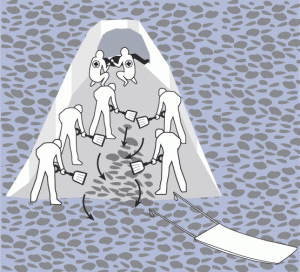 In order to get an efficient platform for extended medical care as well as a loading zone for the patient, shovelers continue moving snow out of the way until the body is completely removed.
In order to get an efficient platform for extended medical care as well as a loading zone for the patient, shovelers continue moving snow out of the way until the body is completely removed.
RESULTS?
Begging the question, is this a superior method? Consider the results (see graph at beginning of this article). Atkins and Edgerly conclude that, while having a strategy is a major improvement, they could not report on average excavation times since these varied between 15 and 40 minutes based on the shovelers conditioning and motivation. Genswein, on the other hand, reports conclusively that using the Apex Snow Conveyor technique, in “rock hard” snow, yields average excavation times of 20 minutes or less for burial depths up to 2 meters. With times like that, if you’re buried and your friends utilize this method, you stand a fighting chance of living. Amen.
© 2010
Editors Note: Genswein’s tests were done with a variety of genders, ages, and physical conditioning in very hard snow. In these conditions the only shovels that survived the digging process were those with heat-treated aluminum blades. Extendible handles with D-grips are also highly recommended. Plastic bladed shovels only provide a false sense of security.
Manuel Genswein has been an instructor for avalanche rescue and prevention for over 15 years, teaches avalanche courses in 21 countries, mainly for avalanche professionals, mountain guides and armed forces. He has developed many search strategies and avalanche rescue devices.

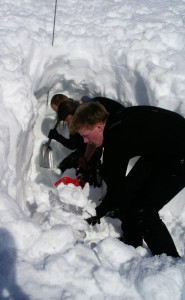
4 comments
11 pings
Skip to comment form
Great article. I tried this technique last season during an avalanche drill at Crystal Mountain. I’m here to say, it worked. I was surprised how quickly my team was able to move a great deal of snow.
Author
Soon as I saw the data with documented results I was convinced as well. It underscored my experience as a single shoveler that hoeing is much faster than repeatedly bending over, straightening up and then throwing.
Kim,
Do you recall how deep you were digging, and how long it took your group to reach the target?
Craig,
The target was about four feet down, and it took us less than ten minutes to uncover the entire thing (it was a sled pack, so slightly smaller than a body). We had five shovelers, and we rotated around every few minutes. The two shovelers closest to the victim worked the hardest, while those behind had it a bit easier. It’s funny that it has taken so long to figure this out.
Kim
Our alpine ski patrol practiced this method in our AVY I course the last two years and found it very efficient. Our resort (Las Vegas Ski & Snowboard Resort) has a base elevation of 8,500 ft. in Lee Canyon.
The name of the canyon tells you that we have big lee side snow accumulations – over 9 ft. this year so far. Using 155 mm artillery and hand charges allows our avalance patrol to maintain safety around the ski area.
Our two avalanche control team members carry Avalungs with along their other avy equipment and are now considering air bag packs. Their problem is that they require other patrollers to help rescue them in the event of one being avalanched
[…] Life-Saving Avalanche Shoveling Technique: Make your friends watch it too… because it’s hard to shovel yourself out. […]
[…] The Human Snow Conveyor | EarnYourTurns […]
[…] the use of airbag packs or other survival strategies. In the event people are caught and buried, efficient shoveling techniques are essential for […]
[…] Start probing at the closest point in a spiral around the zone and prepare to dig furiously (with a strategy). The default settings are well thought out as are some of the less appreciated features such as […]
[…] touring buddies. Though I know strategy makes a difference in digging, I’ve never practiced a body excavation with shovels and I’m not alone here, of that I am […]
[…] Related Posts Canadian study reduces avalanche survival time Buried Alive Shoveling Strategy […]
[…] want to make sure you’re beepin’ and your buddies can find you quickly. Whether or not you know how to dig is another subject, but here’s three reasons why the Tracker 2 is tops in my list of beacons I […]
[…] simulation, like being buried with an avalung for at least five minutes, 15 if you dare, or doing a real dig for a full sized dummy two meters […]
[…] of airbag packs or other survival strategies. In the event people are caught and buried, efficient shoveling techniques are essential for […]
[…] make sure you’re beepin’ and your buddies can find you quickly. Whether or not you know how to dig is another subject, but here’s three reasons why the Tracker 2 is tops in my list of beacons […]
[…] it, and the snow did pile up behind the front line, rather than get moved further downhill as Genswein’s report on shoveling strategies […]